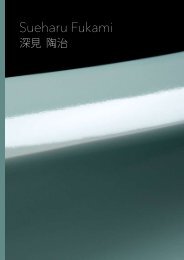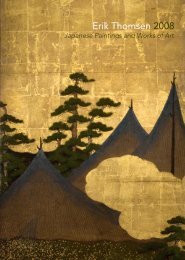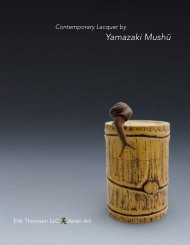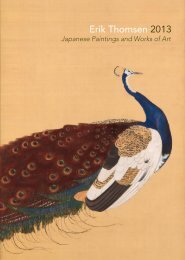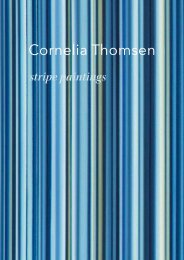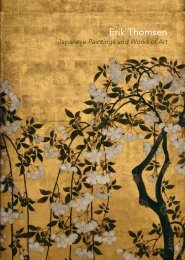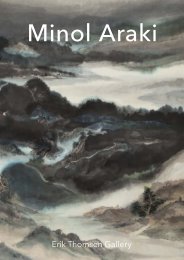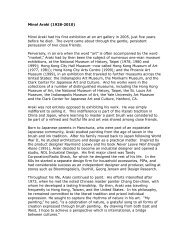View publication (pdf file 6.5 mb) - Erik Thomsen
View publication (pdf file 6.5 mb) - Erik Thomsen
View publication (pdf file 6.5 mb) - Erik Thomsen
- No tags were found...
You also want an ePaper? Increase the reach of your titles
YUMPU automatically turns print PDFs into web optimized ePapers that Google loves.
tribute to the older monk. After several years ofhard practice, Eka received the Dharma transmissionfrom Bodhidharma. During the lifetime ofEka, Buddhism suffered under persecutions in China.Nonetheless, he is recorded as having preachedfor over forty years and coming to rest at the highage of 107.The earliest extant biographies of Zen Patriarchs isthe Biographies of Eminent Monks (519) ( 高 僧 傳 ;Japanese: Kōsōden; Chinese: Gaoseng zhuan) andits sequel, Further Biographies of Eminent Monks( 続 高 僧 傳 ; Japanese: Zoku Kōsōden; Chinese: Xugaoseng zhuan), written in 645 by Daoxuan ( 道 宣 ;596 – 667). For the Japanese monks, however, thefourteenth-century compilation Transmission ofthe Lamp ( 伝 灯 録 ; Dentōroku), by Keizan Jokin(1268 –1325), a collection of 53 enlightenment storiesbased on the traditional legendary accounts ofthe Zen transmission between successive mastersand disciples, became very influential. 1 Althoughthe stories are semi-legendary, they came to takeon real importance for the early modern Japanesemonks, such as Hakuin. 2 Although Hakuin’s inscriptionquotes sections of the Transmission of the Lamp,there are sections that do not appear there or inother known texts. As all of Hakuin’s Second Patriarchpaintings have variations in the text, it seemssafe to say that Hakuin worked from memory andadded or amended sections as he saw fit.Many portraits of Zen patriarchs by Hakuin exist,and he is famous for his images of the Bodhidharmaand of the Kannon, which comprise the largestgroup of extant Hakuin paintings. There are, however,very few paintings of the Second Patriarch. 3 Accordingto the great Hakuin scholar Takeuchi Naoji竹 内 尚 次 , the portraits of the Second Patriarch areimportant as a representation of Hakuin’s earliestextant paintings—he suggests that a painting similarto the present work was brushed by Hakuin in histhirty-fifth year. 4 Moreover, Takeuchi provides noexamples of Second Patriarch paintings brushedafter the earliest period of painting. 5 This makesthe Second Patriarch paintings rare, as Hakuinclaimed to have burned all his earlier paintings.Furthermore, it could well be significant that Hakuinonly painted the Second patriarch painting in hisyounger days, at a time when he was still strugglingwith the principles of Zen Buddhism. At times hesurely must have felt like the Second Patriarch himself.And as he writes in his inscription (»On one hand,rejoice! On the other, how sad!«), Hakuin seems notentirely at ease with the message of extreme selfmutilationthat the story valorizes. Perhaps he wasable to separate himself from the pressing messageof the story of the arm-sacrificing monk as hegot older and more settled into Zen practice.The painting is also of interest in the way it showsHakuin, the painter, working with shapes. Lookingat the composition, one can see a carefully orchestratedsemi-circle of triangular shapes, startingwith the monk’s hat in front and repeating with pinetrees behind. The receding line of similar shapesworks to anchor the monk firmly into the compositionof this painting and further emphasizes thekey point of the story: the permanence, duration,and perseverance of the monk as he stands rootedto the garden ground over night while the snowpiles up around him. It is a fine example of howa painting’s composition reinforces its motif. It alsoreminds us that the often haphazard-looking appearanceof Hakuin paintings might well be anythingbut spontaneous: the compositions are likelythe result of much consideration of shapes andpainterly ideas.The painting is housed in a kiri box that was certifiedand inscribed in February 1960 by the Hakuinauthority Tsūzan Sōkaku (1891–1974), the seventeenthabbot of Hakuin’s old temple, the ShōinjiTemple in Hara.52



